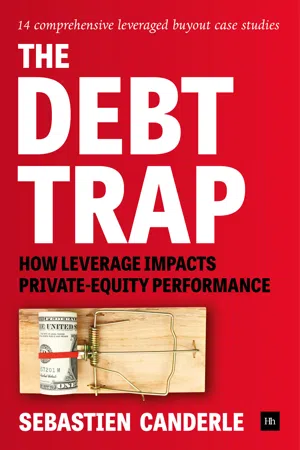
- English
- ePUB (mobile friendly)
- Available on iOS & Android
About this book
This is the inside story of private equity dealmaking.Over the last 40 years, LBO fund managers have demonstrated that they are good at making money for themselves and their investors. But when one looks beneath the surface of the transactions they engineer, it is apparent that these deals can, at times, go spectacularly wrong.Through 14 business stories, all emanating from the noughties' credit bubble and including headline-grabbing names like Caesars, Debenhams, EMI, Hertz, Seat Pagine Gialle and TXU, The Debt Trap shows how, via controversial practices like quick flips, repeat dividend recaps, heavy cost-cutting and asset-stripping, leveraged buyouts changed, for better or for worse, the way private companies are financed and managed today.From technological disruption in the worlds of music recording and business-directory publishing to economic turbulence in the gambling, real estate and energy sectors, highly levered corporations are often incapable of handling market corrections when debt commitments start piling up. Behind the historical events and the financial empires erected by some of the elite private equity specialists, these 14 in-depth case studies examine how value-maximising techniques and a short-cut mentality can impact investment returns and portfolio assets.Whether you are a PE practitioner, investor, business manager, academic or business student, you will find The Debt Trap to be an authoritative and fascinating account.
Frequently asked questions
- Essential is ideal for learners and professionals who enjoy exploring a wide range of subjects. Access the Essential Library with 800,000+ trusted titles and best-sellers across business, personal growth, and the humanities. Includes unlimited reading time and Standard Read Aloud voice.
- Complete: Perfect for advanced learners and researchers needing full, unrestricted access. Unlock 1.4M+ books across hundreds of subjects, including academic and specialized titles. The Complete Plan also includes advanced features like Premium Read Aloud and Research Assistant.
Please note we cannot support devices running on iOS 13 and Android 7 or earlier. Learn more about using the app.
Information
Table of contents
- Contents
- Preface
- Abbreviations and Lexicon
- Introduction
- Chapter 1. Tricks of the Trade
- Part One. Asset-Shifting: Secondary Buyouts and their Offspring
- Chapter 2. Gala Coral – Game on!
- Part Two. Asset-Flipping: Recaps and Quick Flips, or the Art of Making a Quick Buck
- Chapter 3. Hertz – The Need for Speed
- Chapter 4. Celanese – Rich Chemistry
- Part Three. Financial Engineering and the Risks Pyramid
- Chapter 5. TXU – Power Struggles
- Chapter 6. EMI – Out of Tune
- Part Four. Repurchases or Relapse Buyouts: Seller’s Remorse
- Chapter 7. PHS – Washed-up
- Chapter 8. Frans Bonhomme – Down the Drain
- Part Five. Listing, Delisting, Relisting: On a Fool’s Errand
- Chapter 9. DX Group – Going Postal
- Chapter 10. Debenhams – Debt Never Goes Out Of Fashion
- Part Six. Private Investments in Public Equity: PIPE Dream or Nightmare?
- Chapter 11. PagesJaunes – The French Disconnection
- Chapter 12. Seat Pagine Gialle – The Italian Job
- Part Seven. PE-backed IPOs: The Search for a Patsy
- Chapter 13. eDreams – Reality Fights Back
- Chapter 14. Foxtons – Timing the Market
- Part Eight. Asset-Stripping: Modern-day Creative Destruction
- Chapter 15. Caesars Entertainment – PE’s Version of Strip Poker
- Part Nine. Trick or Treat
- Epilogue. Sheriffs and Cowboys
- Acknowledgements
- About the author